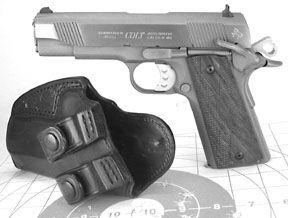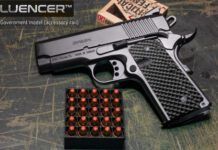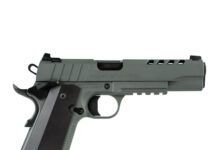
To produce a sidearm that is portable, the key is to reduce weight and size. Before the advent of durable plastics such as polymer, the only alternative was to fashion the frame from a metal alloy. Minimizing the weight of the barrel and slide is generally limited to making it shorter, which also makes the gun more concealable and easier to draw. A number of manufacturers have expanded their product lineup by adding smaller and smaller versions of full-sized models while leaving the basic design intact. One of the first variations in size that stayed true to the original design was the Colt 1911 Commander. This pistol first became available shortly after World War II. The primary variation from the Government model was a reduction in barrel length from 5 inches to 4.25 inches. This made the Commander more portable and easier to handle without reducing magazine capacity.
The subjects of this test not only have shorter barrels but also employ alloy frames further reducing their weights. Our three test guns were chosen because they represent different ways of getting the job done. Of the three pistols in this test the lightweight Colt model was the most direct descendent of the original Commander. Kimber’s Tactical Pro II was a radical variation with a shorter barrel set atop a full size 1911 frame. Our third test gun was the High Standard Crusader Combat Lightweight. This 1911 sells for much less than either the Colt or the Kimber, so we were hoping we had found an inexpensive downsized 1911. Here’s what we learned.
[PDFCAP(1)]The last time we tested the Colt Lightweight Commander the results were published in our January 2002 issue. Matched against the Kimber STS Pro Carry II and the Springfield Compact, the Colt was awarded “Our Pick” over the other two pistols. Not much has changed since then. The latest Colt ran without malfunction and was again the most accurate pistol in the test. The Colt had a classic look while incorporating some modern features. This included a matte frame, checkered wood grip, relieved hammer and trigger plus a serrated backstrap and smooth front strap. The stainless steel slide was shiny on the sides and frosted on the top to reduce glare. The thumb safety was ambidextrous and cocking serrations were fore and aft of the ejection port. Sights were a three dot system, the rear unit being rather tall but adjustable for windage only. The Colt shot to point of aim at 25 yards nonetheless. A firing pin safety was attached to the trigger, but we did not find that it interfered with a controlled press. The Colt’s trigger broke at 6 pounds. The sensation was soft and progressive rather than “crisp as breaking glass,” but a look at accuracy results points out that this type of trigger can be effective.
[PDFCAP(2)]Our test ammunition included two 230-grain rounds from Black Hills. One was topped with a full metal jacket (FMJ) bullet and the other a jacketed hollowpoint loaded to +P velocity. The third round was the Winchester USA (45A) 185-grain FMJ ammunition. We must point out that pistols with shorter slides often demand high-pressure rounds for more slide velocity. This usually means lighter bullets as well. We found that while our other two pistols were fussy about ammunition, the Colt was more than willing to go with a variety of ammunition, including the low recoil Winchester “target” ammunition. There was no sign of sluggishness or uneven cycling. A contributing factor might have been the use of a full-length guide rod. The combination of a long guide rod with a bushing lockup on some pistols makes field stripping awkward or downright frustrating, but Colt has managed to coordinate this design so that parts can be removed easily. A bushing wrench was supplied but some shooters may find it unnecessary. The Colt was the only gun of the trio that was shipped with (2) flush fitting 8-round magazines. Its competitors arrived with 7-round magazines, so we think this is a bonus. The magazine well of the Colt had been treated to a mild bevel to ease reloading.
At the range we settled in to our sandbag rest and were immediately able to put two magazines worth of Black Hills 230-grain FMJ bullets into the black. In a series of five shot groups, we achieved an average measurement of 1.8 inches. Firing the 230-grain JHP+P from Black Hills, our smallest group measured 1.6 inches, but the average worked out to 2.2 inches. The 185-grain Winchester rounds resulted in an average group size of 2.4 inches. We think any over-the-counter handgun that shoots 2.5-inch groups or smaller is certainly worth a look. Overall our average group size for all shots fired was 2.2 inches.
[PDFCAP(3)]The Tactical Pro II is an upgrade of the STS model tested in the January 2002 issue. Upgrades included 30-lpi checkering on the front strap, an extended magazine guide, and night sights. Matched with the 20-lpi checkering on the backstrap, we think the hold on this pistol is improved. The underside of the trigger guard is also finely checkered, but we think this feature proved to be unnecessary. Due to the magazine guide neither of the two remaining pistols in this test came close to the Kimber when it was time for a speedy reload. The night sights shone brightly and were a welcome addition. The 7-round magazine came with an extended base pad so the bottom surface was not lost in the magazine well extension. The Tactical Pro II had very pleasant two-tone features, but overall the gun looked long in the grip but short on top. This is because the barrel was about 0.3 inches shorter than the standard Commander length and the magazine extension added approximately 0.25 inch to the grip. This doesn’t aid concealment because it is the butt of the gun that gives it away when you bend over, not the barrel.
Several solutions have appeared over time to make the 1911 more concealable. The first was by Colt when they introduced the Officer’s model, which featured a shorter frame and a 3.5-inch barrel. A sacrifice of one round (6 in the magazine) was made to make the butt of the frame easier to hide. However, the shorter barrel and slide created reliability problems. To improve concealment but avoid cycling problems, some chose to simply cut down the Commander’s frame. A less expensive way to go was to mount a Commander slide upon an Officer’s model frame, restoring the necessary length of slide stroke for reliable operation. One famous custom gunsmith, Ed Brown (573-565-3261) now offers a modification where the butt is chopped off at an angle so that full frame capacity can be maintained but “printing” is minimized.
However, by shortening only the barrel and slide of the Tactical Pro II Kimber is taking its own approach. We think this design does little to improve concealment but does speed presentation and target-to-target transition. But did the shorter slide effect performance? We did have about a 3% failure to feed problem with the Tactical Pro II but we couldn’t be sure cycling in relation to slide length contributed to the problem. Each of these malfunctions came after the gun had sat in the safe for a day or two. Fresh lubrication seemed to solve the problem each time. Perhaps break in was the answer. It is interesting to note that despite the Tactical Pro II being the smallest in terms of length, this pistol also weighed the most. At 35 ounces total, the top end (slide, barrel, guide rod and recoil spring) accounted for 18 ounces. The top end of the High Standard and Colt pistols each weighed approximately 2 ounces less. The difference in weight is largely due to use of a bull barrel, which requires a full length guide rod and has much thicker walls than a straight, thin barrel which is fit to a bushing. In terms of accuracy the Kimber Tactical Pro II finished second to the Colt but still averaged a 2.5-inch group for all shots fired. This is about the same as for the STS model tested in 2002, which actually averaged 2.3-inch groups but with different ammunition under different conditions.
One other difference between the earlier STS II model and the Tactical Pro II is that the arch with the grip safety has been contoured, making it easier to operate. This is important because the firing pin block is released when the grip safety is compressed. This system was adopted to avoid interference with the quality of the trigger, and indeed we liked the Kimber’s trigger the best of our three guns. We could not trace any malfunctions to this system. However, some of our staff, depending on the shape of their hands, suffered painful blisters on the thumb side at the web of the strong hand. We thought this was unusual given the supplied full diameter grips. Last month we tested the full size Kimber Team Match II and found it to be the most comfortable pistol in the test. However in the case of the Tactical Pro II, not everyone is going to be pleased with its ergonomics. For some, this will be a difficult fit.
[PDFCAP(4)]When we first handled the Crusader Combat Lightweight, we assumed this was a sub-$500 pistol. It seemed awfully cobby, not at all like the 1911s that have risen from CNC machines since the mid 1990s. Indeed, we felt as though we had stepped back in time to the age when the 1911 had fallen out of favor and mass production guns such as the Glock pistols were taking over the market. The reputation that a Glock was just as reliable as a revolver but much higher in capacity made it a more powerful weapon in the market place than the 9mm Parabellum it was originally chambered for.
Meanwhile the 1911 pistol was mired in production techniques that lagged in both quality and timely delivery. Still at $500 we were prepared to accept marginal accuracy from the Crusader Combat Lightweight if it were merely reliable. Once we were informed that the MSRP was actually $695, we suddenly expected more. After all, in this price range there are many pistols that can deliver good to excellent service.
In terms of appearance the High Standard was by no means a homely gun. Its dark alloy frame sat comfortably in our hands. The wood grip panels were handsome and pleasingly cut. The hammer was relieved and the magazine release was checkered. The internal design included a short guide rod system. The grip safety was a standard tang, not enlarged. The backstrap was lined but the front strap was left uncheckered. Cocking serrations were at the rear only and the slide was topped with a matte finish. The sights included an orange painted ramp up front and what appeared to be a Millett design in the back featuring a white outlined notch with white rectangle in the center. This unit was adjustable for windage only. Our initial inspection of the High Standard showed that pressing down on the barrel hood, especially after racking the slide, resulted in substantial movement of the barrel. We also found that the slide would eagerly jam open with the slide stop well beyond the locking notch. Manually locking open the slide took great care. After about 40 shots the grip panels worked loose but worse yet the grip safety became useless. By the time we ended our test we observed that the extractor and the firing pin stop was no longer seated firmly in place. In our test session we were experiencing about an 8% percent failure rate. Here again the Crusader Combat Lightweight turned back the clocks.
A common 1911 problem used to be last shot or first shot flyers. In this case our first three shots were usually pretty good. Then as the magazine emptied and no longer added support to the top end the accuracy deteriorated. Actually, it would have been very easy to fake some good groups. On target 1, for example we could have fired 3 or 4 shots from a magazine, removed the half empty mag, replaced it with a fully loaded one and quite possibly shown a group measuring in the 3-inch range. We also found it possible to come up with two groups on the same target, one in the 3-inch range and another in the 5-inch range printed to one side. The smaller group consisted of shots 1-3 of two different magazines and the larger group consisted of shots 4-7. That we could come up with groups as tight as we did was actually quite surprising. At the chronograph we only collected data for one variety of test ammunition. Actually instead of firing 5 shots we stopped after the second shot. The High Standard was continually jamming at this point and, dealing with trying to get the slide to move forward while all the time knowing that the grip safety was no longer in effect convinced us that recording velocity was meaningless.
Gun Tests Recommends
Colt Lightweight Commander, $950. Buy It. Accurate, light and consistent, this is one of the better choices for .45 ACP carry.
Kimber Tactical Pro II, $1058. Conditional Buy. Basically a sound pistol, the determining factor may very well be shooter comfort. Pick it up, put it down, and then draw it from a holster. If it bothers your hand, it may be wise to choose a different model.
High Standard Crusader Combat Lightweight, $695. Don’t Buy. The barrel would not firmly lock up, and before we could fire 100 rounds the grip safety failed and parts such as the extractor, firing pin stop, grip panels and slide stop had each come loose.




























